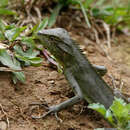tr
kırıntılardaki isimler


Calotes jerdoni, commonly known as the Indo-Chinese forest lizard or Jerdon's forest lizard, is a species of lizard in the family Agamidae. The species is endemic to China and South Asia.
The specific name, jerdoni, is in honor of British biologist Thomas C. Jerdon.[2]
Physical structure: A compressed-bodied lizard. This species resembles Calotes maria in pholidotic (scale) and other characters except that it has 45-57 scales round the body; gular scales much larger than the ventral scales; there is an oblique curved fold covered with small granular scales in front of the shoulders; nuchal crest less prominent; the hind-limb reaches to the eye or not quite so far.[3] Dorsal and lateral scales directed upward.
Color pattern: Deep-green dorsal coloration with yellow, orange or brown spots, but in many cases can make the body into a dark brown within a few seconds.
Length: Maximum total length (including tail): 38.5 cm (15.2 in).[3] Common total length: 32 cm (13 in). Common snout-to-vent length (SVL) : 9 cm (3.5 in).
Maximum published weight: ? g.
Bangladesh, Bhutan, China (W Yunnan, Xizang = Tibet), India (Khasi Hills in Assam & Shillong) and Myanmar.
Bengali: সবুজ গিরিগিটি (Sabuj girigiti), সবুজ রক্তচোষা।
Bhutanese: tsitsimarm
Burmese: ?
Chinese: ?
English: Green forest lizard, Green garden lizard, Indo-Chinese forest lizard and Jerdon's forest lizard.
Hindi & Assamese: ?
Terrestrial & arboreal; diurnal;[3] found in many types of forested land. Prefers dense and bushy hill forest.[4] A skillful and an adept climber, it moves over trees and bushes rather swiftly. It is active during the day time.[4]
Insectivorous; feeds largely on insects but at times bird-eggs, nestlings, and frogs too are eaten up.[4]
Oviparous; breeding season begins around April when males develop bright coloration in the forebody and begin to chase females. Female digs a small hollow in soft earth and lays 11-23 eggs in it for incubation and safety.[4]
No known practical uses. Play rolls in ecosystem by eating various types of insects and otherwise.
Non-venomous and completely harmless to humans.
Not Evaluated (NE).
{{cite web}}: CS1 maint: archived copy as title (link) Calotes jerdoni, commonly known as the Indo-Chinese forest lizard or Jerdon's forest lizard, is a species of lizard in the family Agamidae. The species is endemic to China and South Asia.